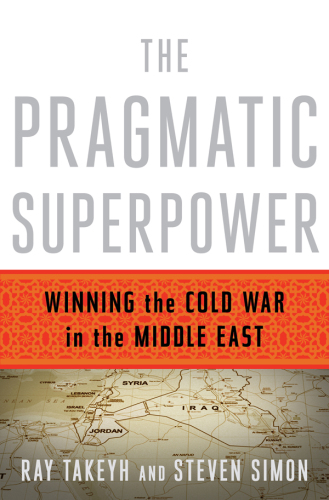
The Pragmatic Superpower
Winning the Cold War in the Middle East
کتاب های مرتبط
- اطلاعات
- نقد و بررسی
- دیدگاه کاربران
نقد و بررسی

February 22, 2016
Former State Department advisors Takeyh and Simon offer a new perspective on the history of U.S. involvement in the Middle East over the last 60 years. They open with the growing tensions between the United States and its erstwhile ally, the Soviet Union, after WWII, and trace how that relationship fared over the course of 10 crises, including the creation of the state of Israel, the coup that put the Shah into power in Iran in 1953, and the Iranian revolution of 1979, culminating with the First Gulf War. Time and again, the authors puncture entrenched myths, such as the view that American involvement in the toppling of Muhammad Mossadeq made inevitable the ascendancy of the ayatollahs two decades later. While contending that resolving the Israeli-Palestinian conflict should not be the U.S.’s top priority, they persuasively establish that America did not suffer “in the Arab world” because of its alliance with Israel. Their lucid and accessible analyses are of more than academic interest—as they note in their prologue, in the tumultuous 21st century “there is an urgent need to look back at a period when the United States got it right.” Agent: Andrew Wylie, Wylie Agency.

February 1, 2016
A singular take on U.S. foreign policy in the Middle East from World War II to the Gulf War demonstrates how a kind of accidental success was achieved by isolating the Soviet Union and avoiding prolonged U.S. entanglements. Takeyh (Guardians of the Revolution: Iran and the World in the Age of the Ayatollahs, 2009, etc.) and Simon (co-author: The Next Attack: The Failure of the War on Terror and a Strategy for Getting it Right, 2005, etc.), both senior fellows in Middle Eastern Studies at the Council on Foreign Relations, look in detail at several (but not all) hotspots during the Cold War that could have potentially led to total destabilization of the region if not for American presidential leadership, diplomatic skill, or pure luck. So what did the U.S. do right, and how can it avoid the current slide back into "timeworn chaos and rivalry"? From the Harry Truman administration onward, American goals in the Middle East were to preserve the petroleum wealth for the West, avoid Soviet infiltration, and resolve the Jewish-Arab homeland dispute--not to promote democratic regimes. Indeed, the U.S. often bolstered autocrats in order to preserve stability. Yet the threat of Soviet infiltration grew dire. Truman and his advisers used the fledgling United Nations to good effect and also mobilized the international community. The authors revisit Iran during two subsequent crises--the disastrous coup to oust Muhammad Mossadegh in 1953 and the eruption of the Iranian Revolution in 1979--though the avoidance of global conflagration following both events was caused more by internal Iranian dynamics than anything the U.S. did. The authors assert that the Suez Crisis detonated largely because of Dwight Eisenhower's wary handling of Gamal Abdel Nasser, who then proved an unlikely ally in keeping the Soviet Union from intervening in the 1958 coups in Syria and Iraq. Regarding the perennial Israeli-Arab flare-ups, the U.S. has proven to be the only superpower able to stay Israel's hand. Contestable yet compelling arguments regarding the state of the "precarious...global scene" following World War II.
COPYRIGHT(2016) Kirkus Reviews, ALL RIGHTS RESERVED.

March 1, 2016
Takeyh (senior fellow, Council on Foreign Relations) was a senior advisor on Iran at the Department of State and has written and testified extensively on Middle East affairs. Simon (senior fellow, Middle East Inst.) has held numerous expert foreign affairs positions, including one year as White House senior director for Middle Eastern and North African affairs. Here the authors argue that U.S. policy in the Middle East, from the formative years of the Israeli-Palestinian conflict to the Gulf War, was successful overall in securing American interests, usually with the overt objective of containing Soviet influence, and that U.S. tactics even had a stabilizing effect on the region. It is true that American diplomacy in the Middle East during the Cold War years consisted of constant negotiation among a complex web of competing interests. Gamal Abdel Nasser's pan-Arabism in the late 1950s was, for instance, poised to threaten U.S. economic interest, while at the same time, Nasser himself was a potential anticommunist ally. As a whole, it is tempting to join the authors in seeing a success story for an imperial power in a postcolonial world. Readers might do well, however, to contrast this positive view with one that presents the United States as a destabilizing influence in the region, such as Rashid Khalidi's Sowing Crisis: The Cold War and American Dominance in the Middle East. VERDICT Recommended mainly for college libraries.--Jeffrey J. Dickens, Southern Connecticut State Univ. Libs., New Haven
Copyright 2016 Library Journal, LLC Used with permission.

























دیدگاه کاربران